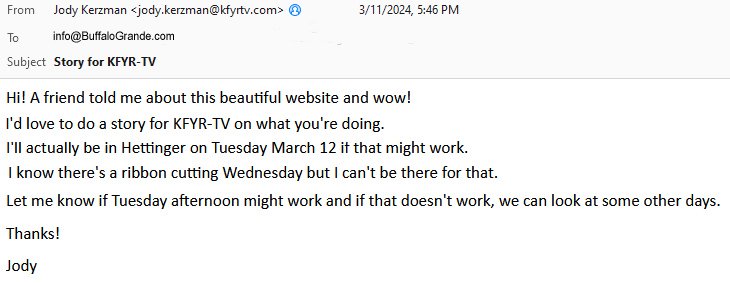Buffalo Grande Foundation celebrateswith Ribbon Cutting in Hettinger
Hettinger Chamber of Commerce, Buffalo Grande Foundation and North Dakota Native Tourism members join to cut the ribbon for the announcement of Buffalo Grande’s new website. Pictured are (left to right) Alyson Kornele, Conni Messner, Val Braun, Josh Raab, Alexis Hicks, Francie Berg, Tyler Erickson, Stacey LaCcompte, LaNae Kristy and Les Thomas. Photo credit: Mike Aschauer
A bright new organization—Buffalo Grande Foundation—met in the Centennial Square on Main Street in Hettinger, ND, March 13, 2024, to cut the ribbon announcing the publishing of their worldwide website.
A core group has been meeting for two years to plan the launching of the website www.BuffaloGrande.com This is a new venture that partners with the tourism tribes of North and South Dakota. It’s a fresh new approach, a new era. Educational and FREE; yet it’s as old as the hills and rugged buttes that surround the area—once teeming with buffalo.
“Welcome to each of YOU who joins us on this incredible journey!!,” announced Val Braun, president of the group. “Together, we’ll share history, legend and the wonderful buffalo stories that never grow old!”
Stacey LaCompte, director of the North Dakota Native Tourism Alliance, was on hand to share the ribbon cutting. With her was Les Thomas of the Turtle Mountain Chippewa, who has worked with tourism for many years.
"Building a Bridge of partnership and collaboration with the Buffalo Grande Foundation allows our Tribal Nations to share and tell our stories with our own voices,” said LaCompte. “This new partnership will provide education and awareness about our Tribal Nations’ unique cultural and traditional ways. The ND Native Tourism Alliance is excited for this opportunity to work with Buffalo Grande Foundation in improving tourism.”
In October members of the Buffalo Grande Foundation attended the Five Tribes Cultural Day at the ND Heritage Society in Bismarck, ND.
Conni Messner, who recently returned to Hettinger after many years, is enthusiastic. “It proved to be a day of enlightenment, sharing, learning and witnessing other people in their culture and beliefs. My vision for the Foundation is to partner with Native Tribes for the benefit of all,” she says.
“I was able to converse with many of the dancers and invite them to our town so we could share our heritage with them. I look forward to having them come here and share their stories and dances with our people and let them see parts of their heritage that many have never seen. I’m also looking forward to visiting the cultural centers of the Native Tribes of North Dakota and South Dakota and learning of their ways.”
The group’s vision is to inform, inspire and bring people throughout the world to a greater appreciation of the intrinsic value of the magnificent buffalo and their centuries-old history on La Riviére Grandé (Grand River) and the Upper Missouri region.
This is the one place in the world where buffalo have always lived and grazed, since time immemorial, says Francie Berg, author of three books about buffalo in the area. “There’s much to learn from this website, but each step is a delight!” she told the crowd.
“Once bound for extinction, the buffalo were rescued one calf at a time by ordinary western people. Only five families in all of the US and Canada successfully rescued buffalo that we know of—three of them with Native roots. We bring you the full narrative including the last great traditional hunts, a known buffalo jump, the people who saved calves and now all of us celebrating our amazing National Mammal—the magnificent bison—in parks, ranches and tribal lands!”
The story of the buffalo, our national mammal, is also the story of the American west beginning with the Ice Age and of the Early Peoples who crossed the Bering Land Bridge perhaps more than 26,000 years ago, according to John Joyce, vice president of the Foundation.
“It is also the story of how intertwined Native populations were and still are with this most noble of beast. One cannot talk about Lewis and Clark or the nineteenth century fur trade in the west without talking about the buffalo, nor about the history of the Great Plains. The buffalo are enduring. They survived the Ice Age and near-extinction by humans in the nineteenth century.“
He notes that the buffalo have always been here. “They bring everything together. The buffalo is the epitome of ecological adaptation on the Great Plains. Why do buffalo matter? They remain a symbol of survival and meaning throughout the centuries!”
You won’t miss anything if you subscribe with www.buffalogrande.com. Sign up here, check your inbox or junk box for a confirmation email and follow the instructions.
Once you have subscribed you’ll be notified whenever there’s new information on the website.
###
__________________________________________
__________________________________________





